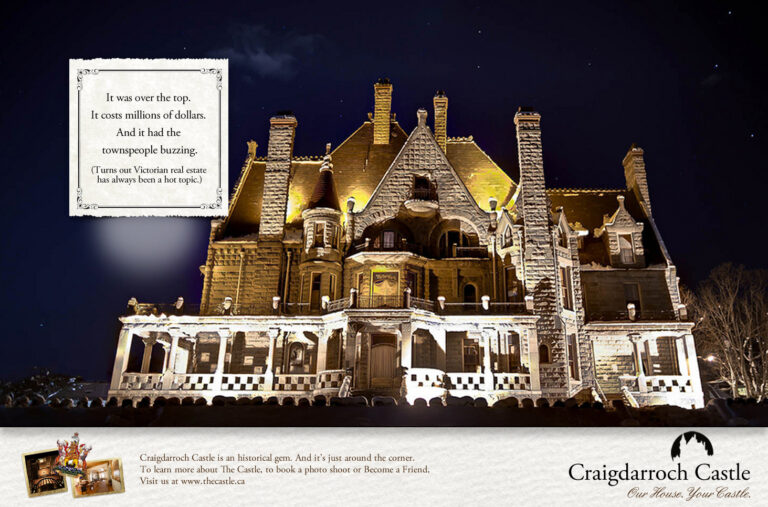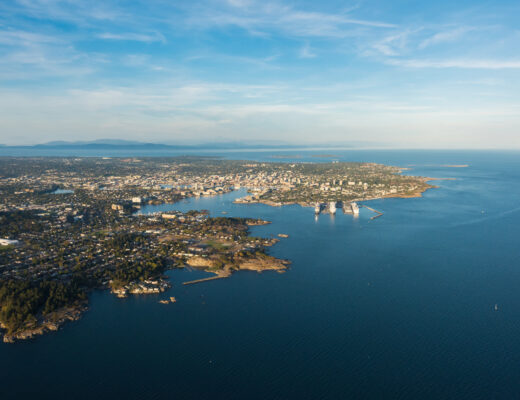In 2014, we conceptualized an absolutely beautiful advertising campaign for Craigdarroch Castle by featuring a few of the many stories from the long and fascinating history while showcasing the exquisite interior craftsmanship with beautiful photography to create a sense of place reflecting the grace of an era when The Castle was truly one-of-a kind in Canada.
This campaign and it’s exceptional copywriting was created with my friend Matt Daley.
The idea behind the campaign was to capture the sense of the grandeur of The Castle and find historical references. For example, the first series made reference to how the Dunsmuir Family had wealth and political power long before the Kennedys of Massachusetts with a little twist about Hyannisport.
Craigdarroch Castle is a definitive Victorian experience. It is a shining example of a “bonanza castle” — massive houses built for entrepreneurs who became wealthy during the industrial age. In this case, the industrialist was Robert Dunsmuir, a Scottish immigrant who made his fortune from Vancouver Island coal.
This legendary Victorian mansion, built between 1887 and 1890 on a hill overlooking the City of Victoria, announced to the world that Robert Dunsmuir was the richest and most important man in Western Canada.
He died in 1889, leaving his entire estate to his wife Joan, who lived in the Castle until her death in 1908.
The immense fortune of the Dunsmuir family is reflected in the four floors of exquisite stained glass windows, intricate woodwork and fabulous Victorian-era furnishings.
The second series made reference to the many mysteries of The Castle and the journeys the Dunsmuir Family members went through in order to have the stained glass windows built, which adorn Craigdarroch Castle.
Thirty two of the forty-seven original art glass windows are still in place. The studio responsible for them remains a mystery. An 1890 newspaper account states that the order for interior woodwork from A.H. Andrews & Co. of Chicago included “windows.”
Paintwork on Craigdarroch’s windows was limited to foliage and flower petals with the exception of a figural panel in the Smoking Room said to depict Sir Walter Raleigh, and another in the Drawing Room based on Sir Frederic Leighton’s exotic 1862 painting, Odalisque.
All of the windows contain complex glass cuts and are assembled in unusually thin and finely soldered lead joints. The profuse use of cut crystal jewels (as opposed to the pressed glass variety) illustrates the exceptional nature of the windows.
The restoration of this National Historic Site is on-going and is it has taken more than 30 years to get it to its current condition. Craigdarroch Castle is a “must see” for any visitor to Victoria.
Art glass windows are a prominent characteristic of Craigdarroch’s decorative scheme. The majority of these windows depict floral themes in flat and rippled clear glass and American opalescent glass. Craigdarroch Castle has one of North America’s finest collections of Victorian residential stained and leaded glass windows, all of which are believed to have been produced by an American studio.
Sometime after Joan Dunsmuir’s death, several art windows disappeared from the Castle. The largest of these windows were removed from the dining room, the sitting room, as well as a bathroom. The Castle Society plans to install reproductions of all the missing stained and art glass windows at Craigdarroch, which will involve careful study of historic photographs.
The Third series made fun of how expensive Victoria real estate was, even in the late 19th century. It was constructed in the late 19th century as a family residence for the wealthy coal baron Robert Dunsmuir and his wife Joan. Robert died in April 1889, 17 months before construction on the castle was completed. His sons Alexander and James took over the role of finishing the home after his death.
Upon the death of Robert Dunsmuir’s widow, Joan, the Craigdarroch estate was sold to land speculator Griffith Hughes for $38,000 who subdivided the estate into building lots. To stimulate sales during a slow real estate market, Griffiths announced that the home would be the subject of a raffle, to be won by one of the purchasers of the residential parcels carved from the estate. The winner, Solomon Cameron, mortgaged the home to finance other speculative ventures which failed, leaving him broke, and in 1919 ownership of the home passed to one of Cameron’s creditors, the Bank of Montreal.
Craigdarroch Castle is believed to have cost as much as $500,000 when it was built, and included granite from British Columbia, tile from San Francisco, and an oak staircase prefabricated in Chicago. When originally constructed Craigdarroch stood in grounds comprising 28 acres (110,000 m2) of formal gardens in Victoria’s Rockland neighbourhood. Craigdarroch Castle has 39 rooms and over 25,000 square feet.
Craigdarroch Castle is a definitively Victorian experience. It is a shining example of a “bonanza castle” — massive houses built for entrepreneurs who became wealthy during the industrial age. In this case, the industrialist was Robert Dunsmuir, a Scottish immigrant who made his fortune from Vancouver Island coal.
This legendary Victorian mansion, built between 1887 and 1890 on a hill overlooking the City of Victoria, announced to the world that Robert Dunsmuir was the richest and most important man in Western Canada.
He died in 1889, leaving his entire estate to his wife Joan, who lived in the Castle until her death in 1908.
The immense fortune of the Dunsmuir family is reflected in the four floors of exquisite stained glass windows, intricate woodwork and fabulous Victorian-era furnishings.
I personally think this series of advertisements reflects everything I learned about advertising over a 40 year period. I think these ads are as good as any I have ever seen.











No Comments